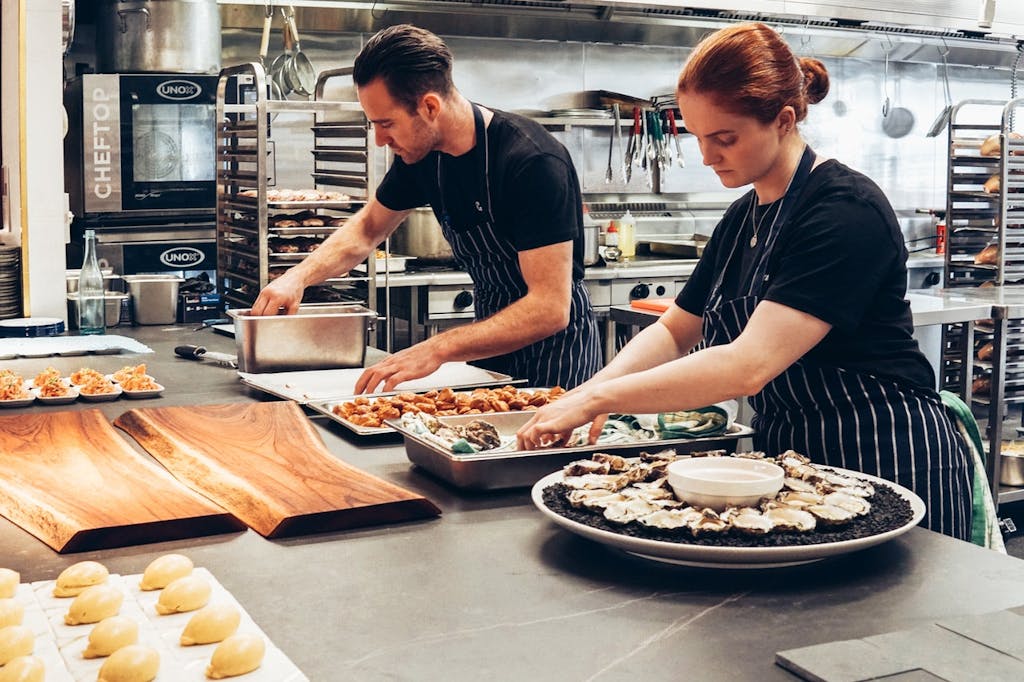Udon Noodles with Gochujang Sauce and Stir Fried Veggies

Udon Noodles in an irresistible sweet and spicy gochujang sauce with caramelized mushrooms and your choice of stir-fried veggies!
This Udon Noodle Stir Fry is an exotic fusion of Asian flavors with nods to Japanese, Korean and Thai cuisine. It’s made with versatile pantry friendly ingredients, on your table in just over 30 minutes and YOU choose the spice level! This udon recipe is made of a soft tangle of delightfully chewy udon noodles (or any noodles you have on hand will work), caramelized mushrooms and crisp-tender vegetables bathed in a savory, sweet, and spicy sauce, laced with heavy hitting fiery gochuchang, earthy tahini, umami-rich soy sauce, peppery Thai basil (or regular), and aromatic garlic, ginger and green onions. Serve it up with some crispy crab rangoons or egg rolls for pure taste bud magic.
Asian Stir-Fried Noodles are a favorite weeknight dinner because they’re quick, easy, pantry friendly and versatile. Don’t miss Pad Thai, Drunken Noodles, Singapore Noodles, Pad See Ew or Korean Noodles.
HOW TO MAKE Udon Noodle Recipe VIDEo
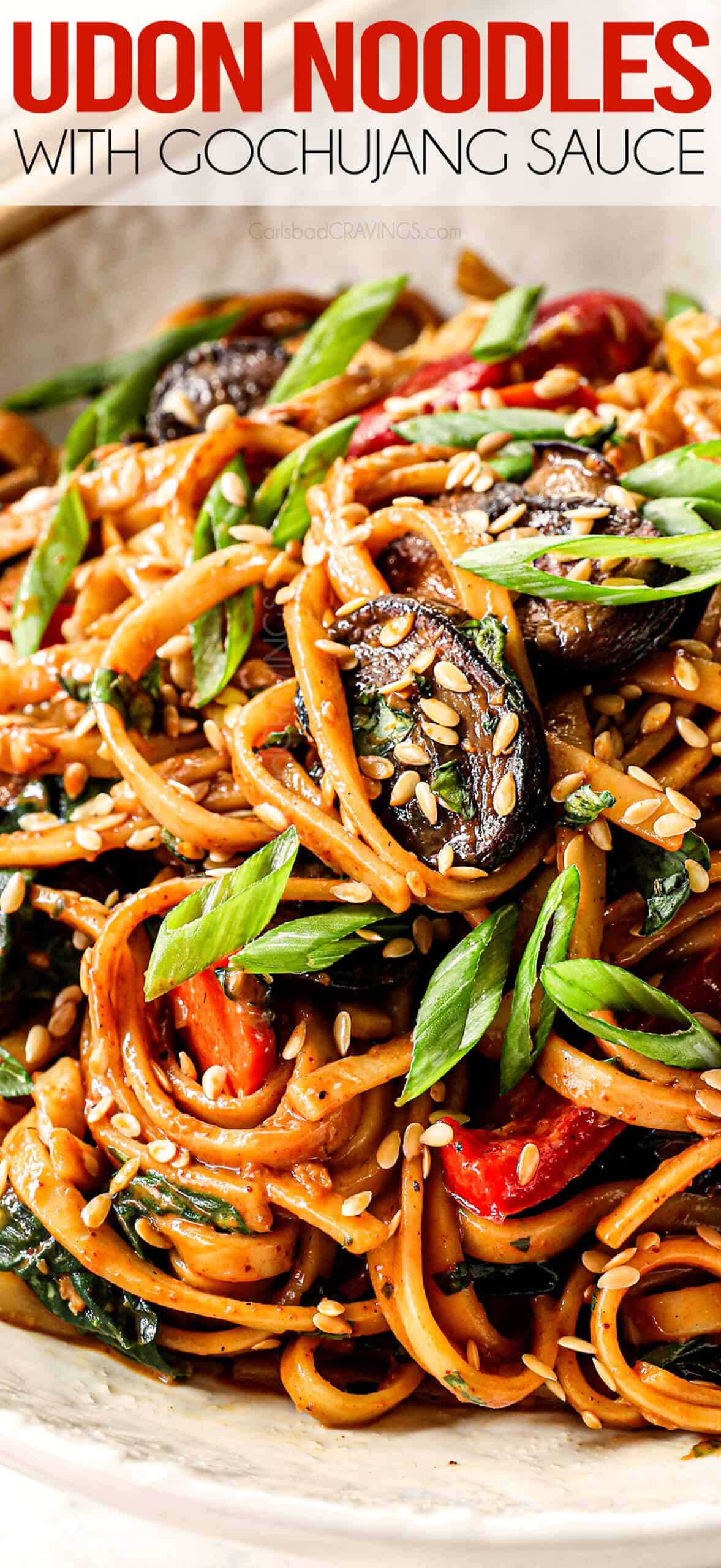

Udon Noodle FAQS
Udon noodles are a delightfully thick, chewy Japanese noodles made from wheat flour, water, and salt. They are glossy white, flat or round and about two to four millimeters. They are a mild noodle which makes them incredibly versatile to use in all your favorite dishes.
Udon noodles are made from wheat flour, water, and salt. As such, they are not gluten free.
Cook udon noodles just like you would spaghetti. Bring a large pot of water to a boil, add the noodles and cook according to package directions. If the noodles are dried, they will likely take between 10-12 minutes. If they are semi-dried, they will take 8-9 minutes. To test, grab a noodle with tongs or a slotted spoon, run under cold water until cool, then taste.
Udon is traditionally made from durum flour, so they have a nutritional profile that’s similar to our American pastas. They don’t boast very much added nutrition, but can be part of a balanced diet when served in proper proportions. One serving of udon noodles has about 310 calories, with 7 grams of protein, 1 gram of fat, and 69 grams of carbohydrates.
When it comes to Japanese noodles, udon and soba are two of the most popular varieties. If you haven’t cooked with both kinds of noodles before, you may be worried they’ll be difficult to differentiate at the store. In fact, they’re both easy to identify even if they’re not clearly labeled:
Udon noodles are made with wheat flour and are glossy white. You’ll find both flat and rounded udon noodles at the store. The noodles are thicker and much chewier than soba noodles. They’re often served in stir fries and soups.
Soba noodles are long noodles made with buckwheat flour and are brown or grey. They’re naturally gluten-free (udon noodles are not) and are similar in appearance to whole wheat spaghetti. They’re nuttier in flavor than udon noodles and are rarely served in soups.
Both udon and ramen noodles are white, long, chewy noodles, but udon noodles are thicker with a more subtle flavor. Udon noodles themselves are always vegan, but ramen noodles are made with eggs. Ramen also is made with kansui (かん水), a salty, alkaline liquid that gives the noodles their signature chewy, springy texture.
Udon Noodle STir Fry Ingredients
This simple udon noodles recipe features a flavorful gochujang sauce and plenty of stir-fry veggies. Here’s a look at what you’ll need to make this recipe (full measurements in the printable recipe card at the bottom of the post):
For the Stir Fry

For the Stir Fry SAUCE

How to Make Udon Noodles
This udon noodle recipe is so quick and easy to make! The entire recipe can be whipped up in about 30 minutes and is easy to customize depending on what veggies you have on hand. Win-win! Here’s a closer look with step-by-step directions (full recipe at the bottom of the post):
Step 1: Cook the Udon Noodles
- Cook the udon noodles in a large pot of boiling water according to package directions.
- Drain and rinse under cool running water.
- Drizzle with oil and toss to prevent the noodles from sticking together.
Step 2: Caramelize the mushrooms
- Add mushrooms to sizzling oil in a large cast iron skillet or Dutch oven. Stir to coat and spread into an even layer (some will overlap which is okay). Cook undisturbed until they turn deeply golden brown on the bottom, about 10 minutes. (You can use this time to make the stir fry sauce).
- Once the bottoms of the mushrooms are golden, give them a stir and continue to cook, stirring occasionally until the mushrooms are deeply caramelized, about 5 more minutes.

Step 3: Make the Gochujang Sauce
- Whisk the stir-fry sauce ingredients together in a medium bowl; set aside.

Step 4: Stir-Fry the Veggies
- To mushrooms, add the bell peppers, carrots, ginger, garlic and the white parts of the green onions.
- Cook for 2 minutes or until the onions are softened.

Step 5: Bring Everything Together
- Add the stir fry sauce and bring to a simmer until slightly thickened, about 1 minute.
- Add the noodles, spinach, and basil and toss until the spinach is wilted, about 1 minute.
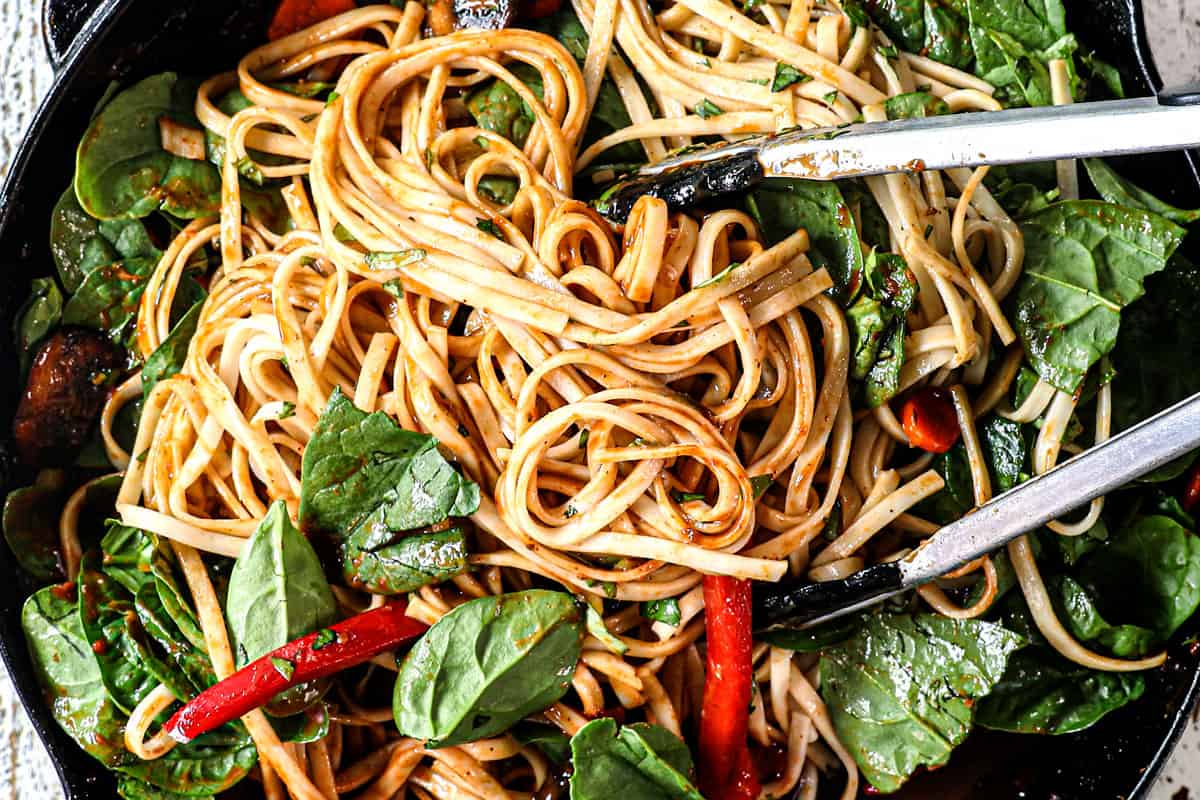
Step 5: Garnish and Serve
- Garnish with remaining green onions and sesame seeds before digging in!
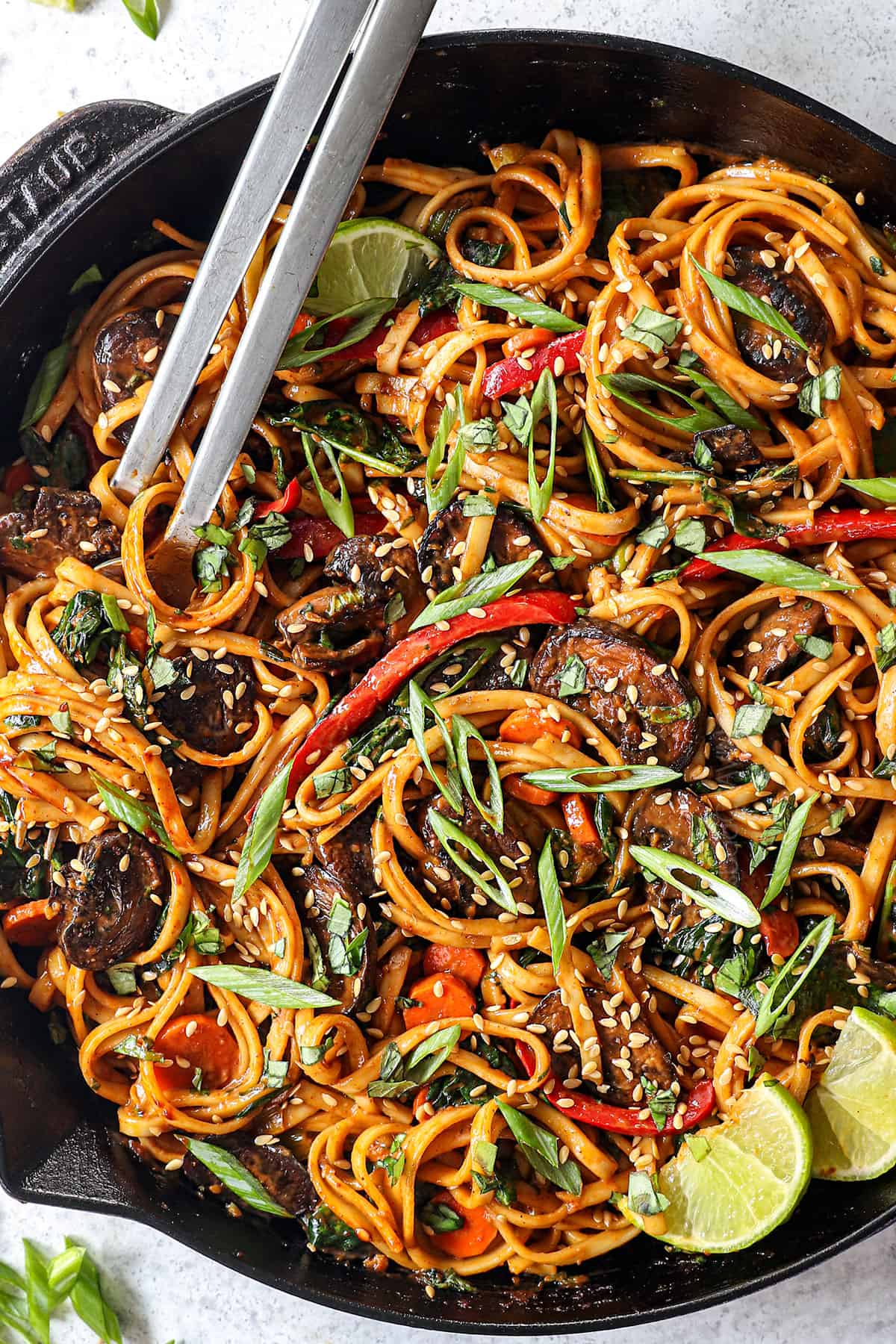

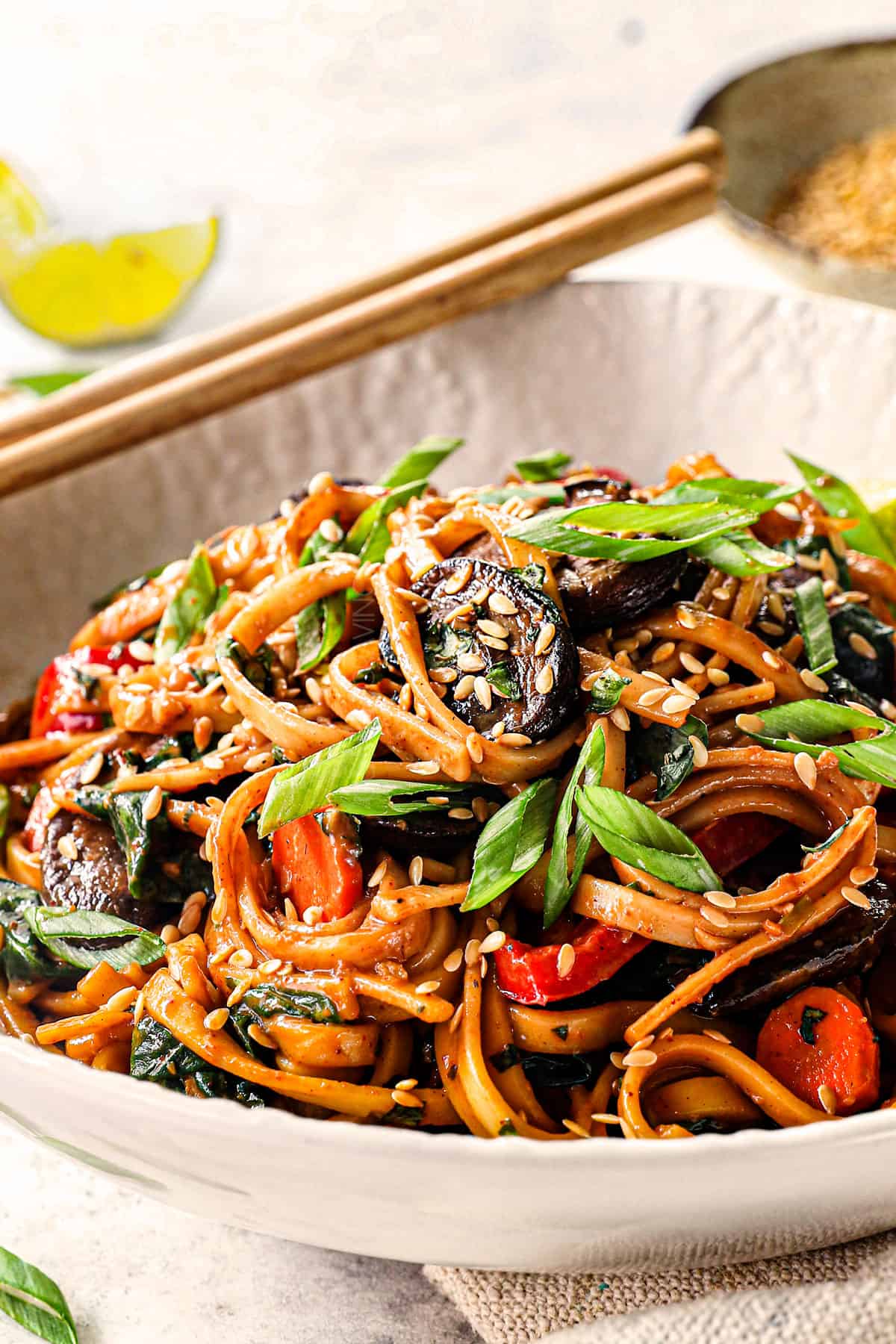
WANT TO TRY THIS RECIPE?
PIN IT TO YOUR Asian, Noodles or Meatless recipe BOARD TO SAVE FOR LATER!
FIND ME ON PINTEREST FOR MORE GREAT RECIPES! I AM ALWAYS PINNING :)!
©Carlsbad Cravings by CarlsbadCravings.com
Save This Recipe To Your Recipe Box
You can now create an account on our site and save your favorite recipes all in one place!
NOODLES AND STIR FRY
- 8 oz. udon noodles (may sub lo mein, ramen or spaghetti)
- 3 tablespoons neutral oil like canola or vegetable
- 8 oz. cremini mushrooms, sliced
- 1 red bell pepper, sliced
- 2 carrots, sliced
- 1 tablespoon freshly grated ginger
- 4 garlic cloves, minced
- 1 bunch green onions, sliced, white and green parts separated
- 3 cups fresh baby spinach, torn
- 1 cup Thai basil, chopped (may sub regular)
- toasted sesame seeds and lime wedges for serving
-
Cook noodles: Cook noodles in a large pot of boiling water according to package directions. Drain and rinse under cool running water. Lighlty drizzle with neutrel oil and toss to prevent the noodles from sticking together; set aside.
-
Cook mushrooms: Heat 3 tablespoons neutral oil in a large cast iron skillet over medium-high heat. Once hot, add the mushrooms, stir to coat and spread into an even layer (some will overlap which is okay). Cook undisturbed until they turn deeply golden brown on the bottom, about 10 minutes. Meanwhile…
-
Make stir fry sauce: Meanwhile, whisk the Stir Fry Sauce ingredients together in a medium bowl; set aside.
-
Caramelize mushrooms: Once the bottoms of the mushrooms are golden, give them a stir and continue to cook, stirring occasionally, until the mushrooms are deeply caramelized, about 5 more minutes.
-
Combine: Add the Sauce and bring to a simmer until slightly thickened, about 1 minute. Add the noodles, spinach, and basil and toss until the spinach is wilted, about 1 minute.
-
Garnish: Garnish with desired amount of green onions and sesame seeds.
Tips and Tricks
- Oyster sauce: Please use QUALITY oyster sauce such as Lee Kum Kee or Kikkoman located in the Asian section of grocery store. You truly can taste the difference and will be sorely disappointed with less quality brands. If you’re allergic to shellfish or are vegetarian, use LEE KUM KEE Vegetarian Stir-Fry Sauce instead of oyster sauce.
- Gochujang (or gochuchang): is a Korean red chili paste primarily made from red chilies, glutinous rice, and soybeans with a complex, savory, spicy, sweet heat. Please do not substitute with another Asian chili sauce – they are not the same!
- Customize the spice level: If you are worried about heat, it’s best to start with less gochujang sauce (about 2 tablespoons) and add more to taste.
- Mix up the veggies: As with any stir-fry, you can use any veggies you’d like in this recipe. Bok choy, broccoli, snow peas, fresh green beans, and more can be used!
- Add protein: Add cooked shrimp, chicken, or beef to your udon noodle stir-fry. See my cashew chicken for how I prepare my chicken.
- Add tofu:Place firm tofu in a pie plate, top with a heavy plate and weigh down with 2 heavy cans (to release water). Set aside for 10 minutes, then chop into 1-inch cubes.
- Make it gluten-free: Use gluten-free noodles (like rice noodles), tamari in place of the soy sauce and gluten-free oyster sauce. Traditional Gochuchang is not gluten free, so you’ll need to seek out a gluten free version like this one on Amazon.

Did You Make This Recipe?
Tag @CarlsbadCravings and Use #CarlsbadCravngs
Leave a Review, I Always Love Hearing From You!




:max_bytes(150000):strip_icc()/types-of-engagement-ring-settings-guide-2000-86f5b8f74d55494fa0eb043dee0de96e.jpg)
